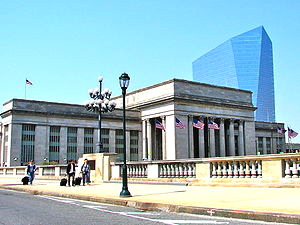30th Street Station Philadelphia

30th Street Station – Philadelphia Landmark
Built by Pennsylvania Railroad, serves more than seven million Amtrak, SEPTA, and NJ Transit passengers a year. Designed by Alfred Shaw of Graham, Anderson, Probst and White.
 30th Street Station is the main railroad station in Philadelphia, Pennsylvania, and one of the seven stations in SEPTA’s Center City fare zone. It is also a major stop on Amtrak’s Northeast and KeystoneCorridors. At the end of fiscal year 2010, a total of 3,787,331 Amtrak passengers used 30th Street, making it the 3rd busiest Amtrak station in the system.
30th Street Station is the main railroad station in Philadelphia, Pennsylvania, and one of the seven stations in SEPTA’s Center City fare zone. It is also a major stop on Amtrak’s Northeast and KeystoneCorridors. At the end of fiscal year 2010, a total of 3,787,331 Amtrak passengers used 30th Street, making it the 3rd busiest Amtrak station in the system.
History

The Station’s art deco main waiting room
The Chicago architectural firm of Graham, Anderson, Probst and White designed the structure, originally known as Pennsylvania Station–30th Street (as with other Pennsylvania Stations). The station is listed on the National Register of Historic Places. Its design was influenced by the Northeast Corridor electrification that allowed trains to pass beneath the station without exposing passengers to soot as steam engines of earlier times had.
Skylight above SEPTA tracks 5 and 6
The station had a number of innovative features, including a pneumatic tube system, an electronic intercom, and a reinforced roof with space for small aircraft to land.
The station opened in 1933, shortly after the peak of expansion by the former Pennsylvania Railroad (PRR), which was headquartered in Philadelphia. It replaced Broad Street Station as the latter became too small to handle Philadelphia’s passenger-rail traffic. The PRR sought a location on its main line between New York and Washington.
Broad St. Station was a stub-end terminal in Center City and through trains had to back in and out. As Broad St. Station handled a large commuter operation, an underground Suburban Station was built as part of the 30th St. Station project to handle it. Because of the Depression and World War II, Broad St. Station continued to operate until 1952.
The opening scenes of the 1985 motion picture Witness were filmed inside the station. It is across from the United States Post Office-Main Branch.

Angel of the Resurrection, Pennsylvania Railroad World War II Memorial (1950) by Walker Hancock.
“Ben Franklin Station”
On December 25, 2005 The Philadelphia Inquirer reported that the Philadelphia-based Pew Charitable Trust had asked Amtrak to change the name of 30th Street Station to Ben Franklin Station. The change would have coincided with the celebration of Ben Franklin‘s 300th birthday in January 2006. The cost of replacing signage at the train station was estimated at $3 million.
On Jan. 13 the Inquirer reported that then-Philadelphia Mayor John Street, who initially said he was unaware of the request, had thrown his support behind the name change. Philadelphians had mixed reactions to the proposal, according to the Inquirer stories. Former Philadelphia mayor and then-current Pennsylvania Governor Ed Rendell was lukewarm, and Amtrak officials worried that a “Ben” station could be confused with its other three “Penn” stations. Pew and Amtrak officials said that conversations were continuing, but the newspaper quoted Philadelphia charity manager H.F. “Gerry” Lenfest as saying that Pew had abandoned its proposal.
On January 25, 2006 Pew announced that it was abandoning its campaign, giving no reason.
Present day
The building is currently owned by Amtrak and houses many Amtrak corporate offices (although Amtrak is officially headquartered in Washington, D.C.). The 562,000 ft² (52,000 m²) facility features a cavernous main passenger concourse with ornate art deco decor.
Prominently displayed is the Pennsylvania Railroad World War II Memorial, a bronze statue which honors Pennsylvania Railroad employees killed in World War II. It consists of a statue of the archangel Michael lifting the body of a dead soldier out of the flames of war, and was sculpted by Walker Hancock in 1950. On the four sides of the base of that sculpture are cast the 1,307 names of those employees in alphabetical order.
The Amtrak 30th Street Parking Garage was designed by BLT Architects and completed in 2004. This nine-level, double helix garage provides 2,100 parking spaces and glass enclosed stair tower and elevator to offer views of Philadelphia. The following year (2005) the Arch Street Pedestrian Bridge was completed and designed with contribution from BLT Architects. The Arch Street Pedestrian Bridge provides direct access for pedestrians from 30th Street Station to the parking garage and Cira Centre; this prevents pedestrians from interacting with heavy traffic from PA 3 and I-76. When the station was renovated, updated retail amenities were added. They include several shops, a large food court, car rental facilities, Saxbys Coffee (formerly Bucks County Coffee), Dunkin’ Donuts, and others. The station was featured in the 1981 film Blow Out, the 1983 film Trading Places, the 1985 film Witness starring Harrison Ford, and the 2010 videogame Heavy Rain.
Rail access
Trains from SEPTA, Amtrak, and New Jersey Transit serve this station.
The three east-west Upper Level platforms serve SEPTA Regional Rail suburban trains.
The north-south Lower Level platforms serve Amtrak and New Jersey Transit trains.
SEPTA’s Market-Frankford Line (also known as the “El”) and all of SEPTA’s Subway-Surface Lines stop at the 30th Street subway station, less than 1/2 block (< 1/10 mile) from the southwest entrance to 30th Street Station. A tunnel connecting the underground subway station and 30th Street Station was closed due to crime and vagrancy concerns.
A number of the SEPTA system’s bus lines include stops at the station on their routes.



